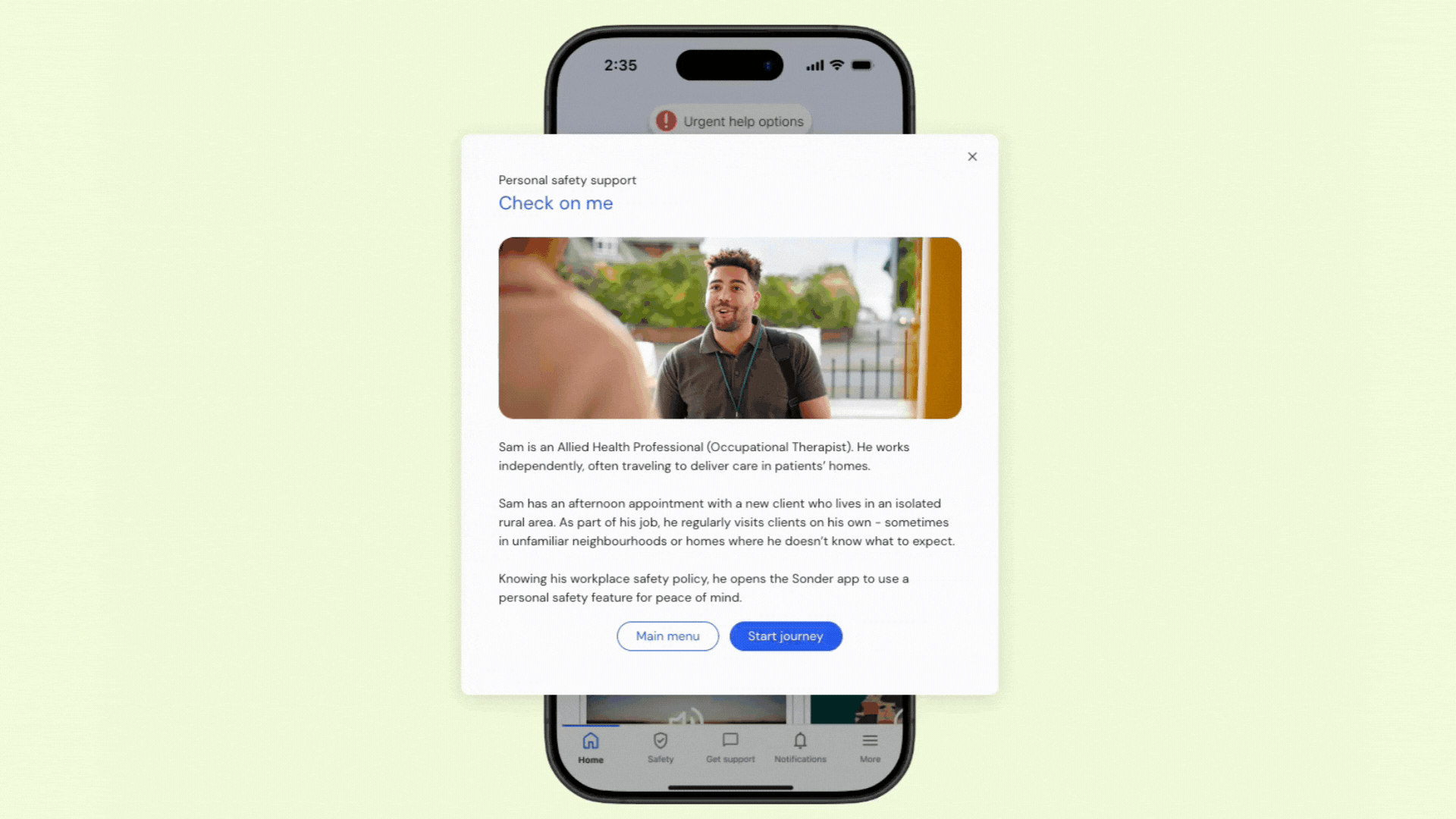When it comes to absence leave management, there is much to juggle. As a senior team leader or HR professional, balancing employee wellbeing with operational needs can feel like a momentous task — not to mention making room for it in an already busy schedule.
With various leave types available, depending on the situation, there’s a laundry list of UK laws and policies to get your head around. On top of this, you have the very real priority of a person’s wellbeing to consider and take supportive action on.
Traditional Employee Assistance Programmes (EAPs) mean well, but they come with limitations. Beyond low utilisation rates, they tend to be reactive (not preventive), only addressing problems once they’ve escalated to a crisis point. But there are other ways.
Disclaimer: The information contained in this article and on this website is general information only and does not constitute legal advice. Although all efforts have been made to ensure the accuracy and currency of the information presented, Sonder takes no responsibility for any errors or omissions presented. Please contact a legal representative for individual advice.
Traditional EAPs were a step forward, but their low engagement and fragmented services have left employees underserved and businesses struggling with rising costs. It’s time to reimagine employee wellbeing with solutions that truly connect, simplify, and deliver meaningful support.

CEO and Co-founder at Sonder
As an organisational leader, you can put systems in place to address molehills before they become mountains. How? By shifting the focus to proactive absence leave management.
Read on to find out how you can stay ahead of absenteeism before it becomes a problem.
The financial and human cost of absence in the UK
Chances are, if you’re an organisational leader, you’ve already noticed that employee absenteeism has very real costs for both employees and the business — but let’s zoom out.
Absenteeism isn’t just a people problem; it’s a business risk:
- According to the HSE, 33.7 million working days were lost across Great Britain in 2023/24 due to work-related ill health and non-fatal injuries. That’s not just time lost; it’s productivity, wellbeing, and revenue.
- The cost of employee absence in the UK is substantial, with £21.6 billion attributed to workplace ill health and injury in 2022/23.
- Presenteeism is also a problem. A report by IPPR reveals that, on average, UK employees lose the equivalent of 44 days’ productivity annually due to working through sickness.
Mental health is the leading cause of long-term absence:
- Out of the 1.7 million workers who reported a work-related illness in 2023/24, around 800,000 were suffering from stress, depression, or anxiety linked to their jobs.
- Over half (53%) of UK employers reported mental health conditions as the main cause of sickness absence in 2024.
Mental health encompasses a variety of conditions. Sonder members’ top five concerns* are:
- Work stress
- Relationship or interpersonal family issues
- General stress or anxiety
- Low mood, anger, unhappiness, and burnout
- Suicidal thoughts
*Source: Why EAPs are failing your workforce (and what to do instead)
Other key contributors to long-term absence include:
- Musculoskeletal disorders: 500,000 affected, with average absences of 14+ days.
- Fatigue: A serious safety risk and hidden productivity killer.
- Common conditions such as migraines, allergies, or medications that cause side effects, yet workers frequently “push through” symptoms, leading to presenteeism.
The human context beyond numbers:
- Beyond the statistics, life events such as bereavement, divorce, or financial stress can disrupt work. But most incident reporting focuses on the immediate event, rarely capturing the underlying human struggles that contribute to absences.
- For employees caring for dependents — whether sick children or elderly relatives — balancing these responsibilities alongside work commitments can take its toll. Without any support systems in place, stress and burnout are very real risk factors.
- A staggering 74% of workers report experiencing significant levels of burnout — feeling stressed by their workload or workplace culture, frustrated, and struggling to get out of bed for work. When employees do take time off due to burnout, it doesn’t solve the issue, as the rest of the team is put under pressure to compensate.
What does effective absence leave management look like?
Effective absence management isn’t just about ticking boxes — it’s about building trust, protecting wellbeing, and enabling business continuity.
As a senior leader or HR professional, your role goes beyond policy enforcement. You’re also a cultural gatekeeper, shaping how your organisation supports its people when they’re most vulnerable. That starts with understanding your legal obligations, but it shouldn’t end there.
Let’s begin by grounding ourselves in the UK legal framework, then explore what it takes to shift from reactive processes to a proactive, human-centred approach.
The legal foundations of leave
The UK has clear statutory leave requirements. Ensuring your absence policy is fair, well-communicated, and consistently applied protects both your people and your business.
Here’s a quick reference guide to the core types of leave:
| Type of leave | Top leadership considerations | Quick resources |
| Annual Leave | Employees are entitled to 5.6 weeks’ paid holiday per year (including bank holidays). Must be managed fairly across teams to prevent burnout and avoid discrimination claims. | Gov.uk Holiday Entitlement |
| Statutory Sick Pay (SSP) | Paid after three consecutive days of absence (including non-working days). Employers must document sickness absences and SSP payments. Consider integrating return-to-work conversations as standard. | SSP overview SSP calculator Statement of fitness for work Assessing and certifying fitness for work |
| Maternity & Paternity Leave | Maternity: up to 52 weeks leave (Statutory Maternity Pay up to 39 weeks). Paternity: 1–2 weeks leave. Ensure managers are trained on non-discrimination and fair treatment during and after leave. | Maternity Rights Paternity Rights Acts and main regulations that govern maternity benefits |
| Parental Leave | Often unpaid. Up to 18 weeks per child, up to 4 weeks per year. Eligibility after 1 year of service. Support planning and flexible working options where possible. | ACAS Guide |
| Time Off for Dependants | Provides emergency leave to manage family issues, like illness or care needs. Usually unpaid, but should be approached with sensitivity. | Gov.uk Dependants Leave |
Beyond legal compliance
Meeting your legal obligations is vital — but that’s just the starting point. Compliance alone won’t prevent burnout, reduce absenteeism, or improve retention.
The traditional model — wait until someone is unwell, then offer support — doesn’t cover all your bases. It’s reactive, often too late, and contributes to a cycle of lost productivity, stretched teams, and rising costs.
For people leaders, this presents a challenge, but also a powerful opportunity. By shifting from compliance-only thinking to a more proactive and preventive approach, leaders can directly impact wellbeing, team stability, and overall organisational health.
Proactive absence management isn’t about stopping people from taking time off — it’s about creating the conditions where fewer people need to.
Employers should encourage employees to use their allotted time off and consider flexible work schedules to reduce fatigue and promote rest and recovery time, especially for frontline workers

Chief People Officer at Sonder
The limitations of traditional EAPs
Employee assistance programmes (EAPs) have become a go-to solution in many organisations, and over 24 million people in the UK now have access to one. But despite good intentions, only 3–5% of employees actually use them.
Why? A report on EAPs by Sonder reveals some common barriers:
- EAPs aren’t built into the company culture: Many workers are unaware they can access an EAP or don’t understand how to use it. Some employees feel they lack “permission” to seek help, worrying about how showing vulnerability might be perceived in the workplace.
- The scope is too narrow: The support is often focused on short-term counselling, capped sessions, and a one-size-fits-all model. But what employees really need is holistic, 24/7 care that addresses a broader range of issues, from physical health to financial and personal wellbeing.
- EAP participation is influenced by past experience: Employees who have previously tried using an EAP may have encountered delays, limited resources, or unhelpful solutions, leaving them reluctant to try again. Distrust in the employer or EAP provider to handle their confidential data with care can also discourage participation.
- They’re designed to react, not prevent: Traditional EAPs step in after the damage is done. But leaders and HR teams are increasingly recognising the need for preventive, early-stage support that helps people stay well, rather than waiting for them to become unwell..
Everyone is an individual and unique, and traditional EAPs have always sort of been about a generic response. Most of the time, that doesn’t work, and people need a much more personalised approach to their care.

Dr Julian Healthcare Platform
In many cases, EAPs are still viewed as a crisis tool, synonymous with short-term counselling and often only used once someone is already struggling. While this support can be valuable, it leaves a significant gap in early intervention and proactive care — the kind that can prevent issues from escalating in the first place.
When that gap exists, employees are more likely to suffer in silence, unable to bring their best selves to work, or in some cases, unable to show up at all. It’s understandable, then, that many HR teams and people leaders are left questioning the true impact of their EAP investment — and are exploring new solutions for reducing absenteeism in the workplace.
Reimagining absence leave management
The good news is there’s a better way.
Human-centred platforms like Sonder offer a smarter, data-driven, and proactive alternative to traditional EAPs — with engagement rates up to 15x higher than traditional EAP models.
What does this look like in practical terms?
1. Proactive, not reactive
Unlike traditional EAPs, Sonder takes a proactive and preventative approach to employee health, safety, and wellbeing. By combining data, technology, and human-led outreach, the platform identifies risks early — whether it’s stress, burnout, or personal safety concerns — and intervenes at the first sign of trouble with tailored, compassionate care.
By addressing challenges holistically and early, Sonder helps reduce the risk of:
- Issues spiralling into long-term absence
- Escalated mental health conditions
- Low engagement and presenteeism
2. Real-time insight, not guesswork
One of the biggest frustrations HR leaders face with traditional EAPs is the lack of meaningful data. You’re often left with little more than generic usage statistics and vague feedback, making it hard to know whether your investment is making a real difference.
Instead of vague reports, Sonder provides anonymised data dashboards that show:
- Emerging risks (by team, region, or time)
- Usage trends (what support is being accessed and when)
- Engagement and ROI
This helps HR teams move from reactive to strategic — designing more targeted interventions and catching issues before they become costly absences.
3. Fully confidential, but insight-rich
Sonder delivers all of this without compromising employee privacy. Dashboards are fully anonymised, meaning HR teams can make strategic decisions using population-level insights — without ever accessing personal details.
4. Support for your managers, too
Sonder reduces the burden on managers by:
- Offering a triage system for wellbeing and safety concerns
- Cutting a manager’s time spent on wellbeing and safety issues by 10%
- Freeing them up to focus on leadership, not crisis management
With the right data, tools, and support in place, organisations don’t just respond better to absence — they prevent it.
Best practices for senior leaders and HR managers
Not sure where to start? Here are seven actions you can take now to strengthen your absence management strategy:
| Action | Application | |
| 1 | Review how leave and wellbeing support is communicated. Many employees don’t know what’s available to them — or don’t feel psychologically safe using it. | Audit your existing leave policies, wellbeing platforms, and internal comms on both. Promote wellbeing services in Slack/Teams, meetings, and check-ins. Encourage and remind staff that it’s okay to seek support before things get serious. |
| 2 | Make support accessible 24/7 and tailored to diverse needs. Out-of-hours issues can quickly turn into workday problems if left unaddressed. | Ensure your wellbeing services are accessible after-hours. Ensure employees can get support quickly — without long GP waits or referral delays. Assure people that all contact with the support programmes are confidential. |
| 3 | Use real-time data to guide your strategy. Leverage tech-savvy support systems, like Sonder, that offer anonymised, real-time data for more informed decision-making. | Spot emerging risks e.g. stress spikes or regional safety concerns. Track uptake, engagement, and outcome trends — not just usage. Adjust your communications and training based on actual needs. |
| 4 | Stay connected during absence. Staying in touch during leave (especially long-term leave) can ease return-to-work anxiety and improve retention. | Schedule regular check-ins. Further Government guidelines here. Keep employees updated on any workplace changes during their time off. Avoid pressuring employees to return — focus on readiness and support. |
| 5 | Run a supportive return-to-work process Keep Britain Working review emphasises that return plans are essential to preventing long-term absence. | Conduct an informal return-to-work interview early in their return. Explore any new support needs and update risk assessments if needed. Ensure managers are trained to lead with empathy. |
| 6 | Offer phased returns or reasonable adjustments. For those returning after illness, injury, or long-term sickness, flexibility matters. | Offer reduced hours, adjusted duties, or work-from-home options if needed. Agree on clear timelines and regularly review progress. Work in line with the Equality Act 2010 where reasonable adjustments are a legal requirement. |
| 7 | Give managers a support system, too. Managers carry the weight of keeping teams well — and often don’t access support themselves. | Give them access to expert support that eases their load. Use a platform like Sonder to help them triage wellbeing and safety issues without carrying it all. Cut down their time spent on issues by giving them the right tech-based tools. |
Final thoughts
Supporting your people through absence leave isn’t just a legal requirement — it’s a leadership responsibility. And the reality is, traditional systems alone can’t keep up with the complex challenges employees face today.
The organisations that will thrive in this climate are those that treat wellbeing and absence prevention as strategic priorities. That means moving beyond compliance and investing in tools that empower both your people and your managers to act early, stay well, and feel supported.
For leaders and HR teams, this shift doesn’t have to mean more complexity. With the right tools in place, it’s entirely possible to reduce absenteeism, improve engagement, and support your managers — all while giving employees access to the care they truly need.
If you’re looking for better employee absence management software in the UK, Sonder’s platform is designed to support this modern, proactive approach. Sonder offers round-the-clock, expert-led care across mental health, physical health, and safety. Combined with real-time data and confidential insights, it helps organisations respond early, personalise support, and make smarter workforce decisions.
Ready to experience a modern approach to employee care? Get in touch with Sonder today to discover how our platform can benefit your organisation.






